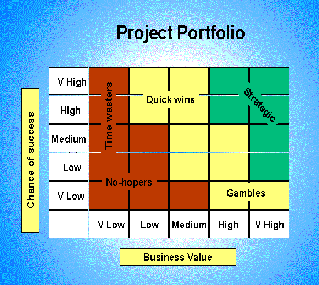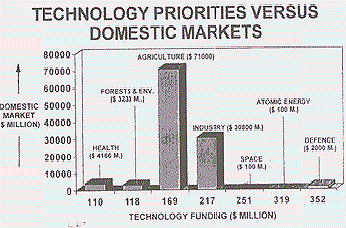|
The Problem
Most businesses have more projects or "initiatives" than they can possibly cope with. Often, the limiting factor is not money but availability of people. Management time and attention is often the scarcest resource. Sometimes unmanageable complexity is the rate-limiting factor. Assigning project priorities can be a difficult and sometimes emotional process.
For all these reasons, management teams often have to chose between different project proposals and arrive at an agreed manageable portfolio of projects/a single project. But how to decide on this crucial issue?

A Potential Solution
Project evaluation and prioritisation has always been of immense importance to businesses and there has been a lot of research in the field of decision-making. Why are poor decisions made? The answer may lie partially in the unrecognised effects of heuristics or rules of thumb which managers use while making decisions. Many heuristics are largely or completely unseen, occurring without the individual recognizing their presence or impact. Human brains have limitations and cannot identify all the alternatives that are important to a particular decision problem. In general, human beings are considered as animals with a small brain, which is not even capable to add or subtract two five-digit numbers. Given a decision problem, managers often frame the scenario inside their brain and then choose the alternative that is often an optimal one but not the best one. When applied to forecasts of resource requirements for a project, management actions taken during an ongoing project, or even reflections on completed project work, these heuristics often manifest themselves as subtle but powerful biases in decision-making.
Research in the field of Management Decision Making by the leading analysts of the world has led to applications of advanced analytical tools to help in managerial decision making. Such a tool is the Multi Criteria Decision Making (MCDM), which identifies the alternatives and attributes to a decision problem and helps the decision-makers reach a conclusion through the formulation of a mathematical model.
Potential Achievements
When judged in the Indian context, applications of such techniques have been very few/negligible. There has been a wide gap between the activities of the national R&D centers and that of the industries. Indian R&D was neither a result of market strategy of the firms nor did the growth/market strategies of the firms ever posed as a problem of challenge to the R&D system (in the in-house private sector or for Government laboratories). But the scenario is changing now, providing opportunities for R&D institutions and the industries to work together and progress.

Application of Decision Support Systems in advanced Decision Making has become a topic of immense importance. At present making decisions regarding investment options has become more complicated and considers more factors and alternatives than just NPV or Cost Benefit Analysis. Research has shown that often 'figures' could lead to faulty decisions. Some major Business Organizations in the world have already called for applications of analytical decision-making tools regarding investment appraisals. The department of Transport, Government of UK, Unilever and Nestle are some of them. The reason as to why such techniques (MCDM) have become so important is because it not only takes into account quantifiable or financial figures but also considers qualitative variables into the model. The results have been outstanding and applications of such tools have become crucial for better business performance within any industry.
Hindustan Lever Limited (HLL) - A Case Study
FMCG sector is faced with challenges of the changing environment in India. Making the right decision regarding different projects including new product development or diversification through innovation and technology is of major concern. For example, let us focus on the food sector of India.
- Food accounts for 50% of all economic consumption in India
- India ranks first in the world in production of cereals, livestock population and milk. It is the second largest fruit and vegetable producer and is among the top five producers of Rice, Wheat, Groundnuts, Tea, Coffee, Tobacco, Spices, Sugar, and Oilseeds.
- The Processed Food Industry ranks 5th in size in the country representing 6.3% of GDP, accounts for 13% of the country's exports and involves 6% of total industrial investment in the country.
- Liberalization of Food Sector commenced in 1991. Removal of price controls, dereservation from small scale, reduction in import controls, fiscal incentives for encouraging investment in the sector have been undertaken by the Government to spur growth.
- Since liberalization in August '91 till December 2000, 6427 proposals for projects of over Rs.538bn (US$11.4bn) have been proposed in various segments of the food and agro-processing industry. Besides this, the Government has also approved 1135 proposals for joint ventures, foreign collaboration, industrial licenses and 100% export oriented units envisaging an investment of Rs194bn. (US $4.1bn).
- However implementation statistics have been extremely poor. Only 12% of the proposed 7500+ projects have been implemented so far. Total outlay to date on implemented projects has been Rs117bn i.e. only 16% of the proposed Rs732bn. Only 13% of the proposed employment has been generated.
- Foreign Investment in the sector has been comparatively more encouraging with a 24% of the proposed projects implemented. Total foreign investment till December 2000 in the Food Processing sector has been Rs.26bn.
Under such circumstances, for almost any decision the number of alternatives has grown dramatically. Moreover, the number and nature of goals, criteria or constraints have changed. For example, while taking up a project the management committee has to consider how HLL's existing system for selling and distribution system throughout rural India could be used to improve the economies for most food products. Or, the committee might have to take into consideration the possibility to create nationwide, mass-market brands because of India's overwhelming ethnic and cultural diversity. Moreover, facts indicate that the top 20 global FMCG companies, generating sales of over $450 bn, have most of their manufacturing units located in high-cost regions of the world. Going by these figures, India does have a significant cost advantage and HLL might think of sourcing as a key factor while undertaking any major project.
Making a major decision amongst such complicated alternatives and attributes is a difficult task and calls for decision support to aid in managerial decision making. The decision support model will be imperative to consider and evaluate all the possible alternatives and then decide upon the best one. Future applications of such decision-making techniques could be in the fields of Transaction Cost Economies/Transfer pricing of International Business/International Finance. It must be noted in this context that no decision-making technique can lead to a perfect decision. But it can definitely help the decision makers ask the right questions.
*Contributed by -
Riddhi Dutta,
MBA Finance,
Leeds University Business School, UK.
|
 |
 |
|